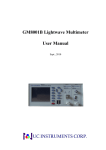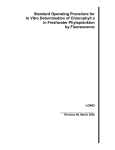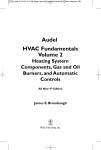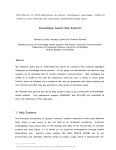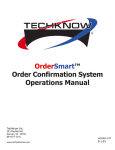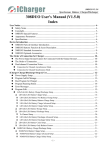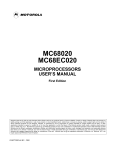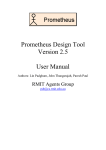Download Chapter 3
Transcript
Cover Page
The handle http://hdl.handle.net/1887/22891 holds various files of this Leiden University
dissertation
Author: Gouw, Stijn de
Title: Combining monitoring with run-time assertion checking
Issue Date: 2013-12-18
Trace Specifications for
Control- and Data-Flow
3
The formalisms described in the previous chapter for specifying object-oriented programs can be categorized in roughly two
categories: those focussing on the control-flow of the program,
and those focussing on the data-flow of the program. Formalisms focussing on the control-flow specify the allowed orderings between method calls, for example using regular expressions, context-free grammars or temporal logics. Formalisms
for describing the data-flow generally use assertions to restrict
the values of fields, parameters or local variables, possibly enhanced by constructs such as pre-post conditions and class invariants for supporting design by contract. But none of described specification languages were developed to combine the
specification of the control-flow with the data-flow in a single formalism. In contrast, the behavior of almost all Java
programs depends on both control-flow and data-flow: for example, the behavior of a stack is fully characterized by the sequence of method calls to push and pop it receives (the controlflow), together with the parameter and return values (the data21
3. Trace Specifications for
Control- and Data-Flow
flow). For Java programs that encapsulate their internal state1
an execution can be represented by the global communication
history of the program: the sequence of messages corresponding to the invocation and completion of (possibly static) methods, including actual parameters and return values. Similarly,
the execution of a single object can be represented by its local
communication history, which consists of all messages sent and
received by that object. The behavior of a program (or object)
can then be defined as the set of its allowed histories. Jeffrey
and Rathke [52] develop a fully abstract semantics based on
histories which coincides with the standard operational semantics.
Let us call the orderings between method-calls and returns
the control-flow of a history, and the actual parameters and
return values the data-flow of the history. In this chapter
we develop a single formalism which allows combining dataoriented properties of the history with protocol-oriented properties. To be of practical use, such a formalism should be userfriendly, amenable to (at least) automated run-time verification
and sufficiently expressive. Below we propose attribute grammars extended with assertions and conditional productions for
the specification of histories, and compare several alternatives
approaches with respect to expressiveness, usability and automation.
Specifications can be used in two different ways: as a description of how an API (in our case, a set of Java classes and
interfaces) must be used by a client (this can be seen as a kind
of formalized user manual), or as an internal specification for
developers of a class to test the class which is being developed.
In the first case, only methods visible to clients can be used
in the specification (i.e. public methods and no self-calls, since
the user has no control over private methods and self-calls), in
the second case for internal use we must also monitor self-calls
and calls to private methods.
1 Encapsulation means that objects do not have direct access to the
fields of other objects. If access to a field x is needed, the programmer
instead adds two methods T getx() and void setX(T val).
22
3.1. Modeling Framework
3.1
Modeling Framework
The modeling framework consists of three basic ingredients:
communication views, grammars with conditional productions,
and assertions. We use the interface of the Java BufferedReader
(Figure 3.1) as a running example to explain these modeling
concepts. In particular, we formalize the following property of
the BufferedReader:
The BufferedReader may only be closed by the
same object which created it, and read actions may
only occur between the creation and closing of the
BufferedReader.
Note that the above property constrains the clients that
use the BufferedReader; in other words, it is a kind of “user
manual” for the reader, but does not guarantee that the reader
itself works properly (since this property does not restrict the
behavior of the reader itself). The property is a little unusual
in that the reader actually cannot even detect whether a client
uses it according to the above specification, since the reader
has no way to detect whether the caller of close is the same
object that constructed it. This last part can be seen as a form
of dynamically checked ownership: the client which created the
reader owns it, and the above property can serve as a first step
to ensure that no information about the reader is leaked to
other clients.
As a naive first step one might be tempted to define the
behavior of BufferedReader objects simply in terms of ‘callm(T )’ and ‘return-m(T )’ messages of all methods ‘m’ in its
interface, where the parameter types T are included to distinguish between overloaded methods (such as read). However,
interfaces in Java contain only signatures of provided methods:
methods where the BufferedReader is the callee. Calls to
these methods correspond to messages received by the object.
In general the behavior of objects also depends on messages
sent by that object (i.e. where the object is the caller), and on
the particular constructor (with parameter values) that created
the object. Moreover it is often useful to select a particular subset of method calls or returns, instead of using calls and returns
23
3. Trace Specifications for
Control- and Data-Flow
interface BufferedReader {
void close();
void mark(int readAheadLimit);
boolean markSupported();
int read();
int read(char[] cbuf, int off, int len);
String readLine();
boolean ready();
void reset();
long skip(long n);
}
Figure 3.1: Methods of the BufferedReader Interface
local view BReaderView specifies java.util.BufferedReader {
BufferedReader(Reader in) open,
BufferedReader(Reader in, int sz) open,
call void close() close,
call int read() read,
call int read(char[] cbuf, int off, int len) read
}
Figure 3.2: Communication view of a BufferedReader
to all methods (a partial or incomplete specification). Finally
in referring to messages it is cumbersome to explicitly list the
parameter types. A communication view addresses these issues.
Communication View
A communication view is a partial mapping which associates
a name to each message. Partiality makes it possible to filter
irrelevant events and message names are convenient in referring
to messages.
Suppose we wish to formally specify the property on page 23.
This is a property which must hold for the local history of all
instances of java.util.BufferedReader. The communication
view in Figure 3.2 selects the relevant messages and associates
them with intuitive names: open, read and close.
24
3.1. Modeling Framework
All return messages and call messages methods not listed in
the view are filtered. Note how the view identifies two different messages (calls to the overloaded read methods) by giving
them the same name read. Though the above communication view contains only provided methods (those listed in the
BufferedReader interface), required methods (e.g. methods
of other interfaces or classes) are also supported. Since such
messages are sent to objects of a different class (or interface),
one must include the appropriate type explicitly in the method
signature. For example consider the following message:
call void C.m() out
If we would additionally include the above message in the communication view, all call-messages to the method m of class C
sent by a BufferedReader would be selected and named out.
In general, incoming messages received by an object correspond
to calls of provided methods and returns of required methods.
Outgoing messages sent by an object correspond to calls of required methods and returns of provided methods. Incoming
call-messages of local histories never involve static methods, as
such methods do not have a callee.
Besides normal methods, communication views can contain
signatures of constructors (i.e. the messages named open in
our example view). As such, the set of signatures that occur in
a communication view is not necessarily a subset of the signatures in the interface it specifies (since Java interfaces do not
contain constructors). In this case, the view selects all calls/returns to an object of a class that implements that interface.
Incoming calls to provided constructors raise an interesting
question: what would happen if we select such a message in a
local history? At the time of the call, the object has not even
been created yet, so it is unclear which BufferedReader object
receives the message. We therefore only allow return-messages
of provided constructors (clearly constructors of other objects
do not pose the same problem, consequently we allow selecting
both calls and returns to required constructors), and for convenience omit return. Alternatively one could treat constructors
like static methods, disallowing incoming call-messages to constructors in local histories altogether. However this makes it
25
3. Trace Specifications for
Control- and Data-Flow
impossible to express certain properties (including the desired
property of the BufferedReader) and has no advantages over
the approach we take.
Java programs can distinguish methods of the same name
only if their parameter types are different. Communication
views are more fine-grained: methods can be distinguished also
based on their return type or their access modifiers (such as
public). For instance, consider a scenario with suggestively
named classes Base and three subclasses Sub1, Sub2 and Sub3,
all of which provide a method m. The return type of m in the
Base, Sub1 and Sub2 classes is the class itself (i.e. Sub1 for m
provided by Sub1). In the Sub3 class the return type is Sub1.
To monitor calls to m only with return type Sub1, simply include
the following event in the view:
call Sub1 C.m() messagename
One may ask: why allow private methods to appear in specifications? After all, private methods cannot be used by an
outside client of the class. The same question arises when considering whether to monitor self-calls or not. By allowing to
monitor private methods and self-calls, the modeling framework and corresponding tool support can also be used by developers of the class, to test the current implementation of the
class in development. Communication views include an optional excludeSelfCalls keyword which indicates per event
whether self-calls must be tracked (for self-calls, the caller and
the callee are the same). While typically developers do not
want to exclude self-calls for the purpose of internal tests, this
keyword is especially useful in public specifications for other
clients, that describe how the class must be used by the client.
Local communication views, such as 3.2, selects messages
sent and received by a single object of a particular class, indicated by ‘specifies java.util.BufferedReader’. In contrast,
global communication views select messages sent and received
by any object during the execution of the Java program. This
is useful to specify global properties of a program. In addition
to instance methods, calls and returns of static methods can
also be selected in global views. Figure 3.3 shows a global view
which selects all returns of the method m of a class or interface
26
3.1. Modeling Framework
global view PingPong {
return void Ping.m() ping,
call void Pong.m() pong
}
Figure 3.3: Global communication view
Constructors
Inheritance
Dynamic Binding
Overloading
Static Methods
Required Methods
Access Modifiers
Table 3.1: Supported Java features that require special care.
(or any of its subclasses) called Ping, and all calls to m on a
subtype of a class or interface called Pong. Note that communication views do not distinguish instances of the same class (e.g.
calls to ‘Ping’ on two different objects of class ‘Ping’ both get
mapped to the same terminal ‘ping’). Different instances can
be distinguished in the grammar using the built-in attributes
‘caller’ or ‘callee’, see the next two sections.
In contrast to interfaces of the programming language, communication views can contain constructors, required methods,
static methods (in global views) and can distinguish methods
based on return type or method modifiers such as ‘static’, or
‘public’. See table 3.1 for a list of supported features which
require special care. For example, to support dynamic binding, the actual run-time type of the callee must be used, instead of the static type of the variable or field in which the
callee is stored. This means that the correspondence between
the messages named in the communication view, and actual
method calls in the program source code must be made at runtime. The other features listed in the table have been discussed
above.
27
3. Trace Specifications for
Control- and Data-Flow
Context-Free Grammars
Now that we have identified the basic messages using the communication view, the question arises how we can specify the
valid orderings between these messages: the protocol. More
specifically, we want to find a notation for the set of the valid
histories (where a history is a finite sequence of messages).
While the histories in this set will be finite (since at any point
during execution, the then current history is finite), the set
itself usually contains an infinite number of histories due to recursion or loops, so we cannot simply write it down explicitly.
We can consider the set to be a language in which each history
is a word, and each message is an alphabet symbol. This suggests we can use existing formalisms for defining languages, in
particular the ones surveyed in Chapter 2. We use context-free
grammars to specify the protocol behavior of histories.
Definition A history is valid with respect to a given contextfree grammar if and only if all prefixes of the history (including
the history itself) are generated by the grammar.
The discussion in Section 3.2 provides a motivation for choosing
grammars over the other formalisms, and a justification for our
definition of a valid history.
The grammar below specifies the valid histories of the BufferedReader:
S
C
::=
|
::=
|
|
open C
read C
close S
Figure 3.4: Context-Free Grammar which specifies that ‘read’
may only be called in between ‘open’ and ‘close’.
This grammar describes the prefix closure of sequences of
the terminals ‘open’, ‘read’ and ‘close’ as given by the regular expression ((open read ∗ close)∗). In general, the message
names given by a communication view form the terminal symbols of the grammar, whereas the non-terminal symbols specify
28
3.1. Modeling Framework
the structure of valid sequences of messages (in particular, the
start symbol S generates the valid histories).
Attribute Grammars and Assertions
While context-free grammars provide a convenient way to specify the protocol structure of the valid histories, they do not take
data such as parameters and return values of method calls and
returns into account. Thus the question arises how to specify
the data-flow of the valid histories. To that end, we first extend
the above context-free grammars with so-called attributes.
Definition Terminal Attributes. Given a terminal T , an attribute of T assigns a value to each instance2 of T (i.e. to each
token of T).
For example, consider a terminal INT LITERAL, and suppose the string “33” is an instance of INT LITERAL. One
could define an attribute val for INT LITERAL, which assigns the number 33 to the string “33”. Note that terminal
attributes can assign different values to different instances of
the same terminal.
In the previous section we saw that (instances of) terminals
correspond to call or return messages. The question arises:
what are sensible attributes for such terminals? Several objects are involved in the sending of the messages: the caller,
the callee, and the actual data being sent in the form of actual parameters or a return value result. We define built-in attributes (named callee, caller, and so on) to capture precisely
those objects involved in the message. In summary, attributes
of terminals are determined (i.e., built-in) from the method
signatures given in the communication view.
Next we define attributes for non-terminals. Unlike attributes for terminals, they are defined by the user in the grammar. Given a context-free grammar G and a non-terminal V ,
let us denote by L(V ) the language generated from the nonterminal V by using the productions of G.
2 A token is a string of symbols. A terminal can be seen as a token
type, whose tokens are considered to be syntactically “similar”
29
3. Trace Specifications for
Control- and Data-Flow
Definition Non-terminal Attributes. Given a set of values
D and a context-free grammar with a non-terminal V , an attribute for V is a function f : L(V ) → D.
Intuitively the above definition states that a non-terminal
attribute assigns values to all of the words generated by that
non-terminal. The value of non-terminal attributes is userdefined: the user must associate with each production, source
code that computes the attribute values of all non-terminals involved in the production. There are two kinds of non-terminal
attributes: synthesized attributes and inherited attributes. In
each production the user defines the value of the synthesized
attributes of the non-terminal on the left-hand side of the production, and the values of the inherited attributes of the nonterminals appearing on the right-hand side of the production.
In general this does not rule out circular attribute definitions
The seminal paper [59] in which Knuth first introduced attribute grammars contains an algorithm which detects circular
definitions. Using actual source code for the attribute definitions ensures that all attribute values of non-terminals are
computable. Of course this source code may not terminate, we
rely on the user to make sure that it does.
In our setting, the grammar non-terminals generate sequences
of call/return messages. Hence, a non-terminal attribute can
be seen as a property of the data-flow of that sequence and
hence, as an important special case, the attributes of the start
symbol of the grammar can be considered as properties of the
data-flow of the history. We are now ready to define attribute
grammars:
Definition An attribute grammar is a pair (G, F ), where G is
a context-free grammar, and F is a set of attributes for G.
Note that the attributes themselves do not alter the language generated by the attribute grammar, they only define
properties of data-flow of the history. We extend the attribute
grammar with assertions to specify properties of attributes.
For example, in the attribute grammar in Figure 3.5 a userdefined synthesized attribute ‘c’ for the non-terminal ‘C’ is
defined to store the identity of the object which closed the
30
3.1. Modeling Framework
S
C
::=
open C1
|
::=
|
|
read C1
close S
{assert (open.caller == null ||
open.caller ==C1 .c ||
C1 .c == null);}
(C.c =C1 .c;)
(C.c = close.caller;)
(C.c = null;)
Figure 3.5: Attribute Grammar which specifies that ‘read’ may
only be called in between ‘open’ and ‘close’, and the reader may
only be closed by the object which opened it.
BufferedReader (and is null if the reader was not closed yet).
Synthesized attributes define the attribute values of the nonterminals on the left-hand side of each grammar production,
thus the ‘c’ attribute is not set in the productions of the start
symbol ‘S’. The extension of context-free grammars to attribute
grammars with assertions and conditional productions (next
called “extended attribute grammars”) naturally gives rise to
the following modification in the definition of a valid history.
Definition A history is valid with respect to a given extended
attribute-grammar if and only if all prefixes of the history (including the history itself) are generated by the grammar, and
all assertions in the grammar were true for every prefix of the
history.
The assertion in the attribute grammar of the BufferedReader
allows only those histories in which the object that opened (created) the reader is also the object that closed it. Throughout
the paper the start symbol in any grammar is named ‘S’. For
clarity, attribute definitions are written between parentheses ‘(’
and ‘)’ whereas assertions over these attributes are surrounded
by braces ‘{’ and ‘}’.
Assertions can be placed at any position in a production
rule and are evaluated at the position they were written. Note
that assertions appearing directly before a terminal can be seen
as a precondition of the terminal, whereas post-conditions are
placed directly after the terminal. This is in fact a gener31
3. Trace Specifications for
Control- and Data-Flow
alization of traditional pre- and post-conditions for methods
as used in design-by-contract: a single terminal ‘call-m’ can
appear in multiple productions, each of which is followed by
a different assertion. Hence different preconditions (or postconditions) can be used for the same method, depending on
the context (grammar production) in which the event corresponding to the method call/return appears. Traditional preand post-conditions are still useful if in every context, the same
assertion must be used: in that case, the assertions in the grammar would be duplicated at every occurence of the appropriate
terminal. In Section 5.1 we show an example which uses traditional pre- and post-conditions.
It is important to note that for a meaningful semantics we
have to restrict the attribute grammars to those grammars
which are side-effect free (with respect to the heap) so that
they don’t affect the flow of control of the tested program, and
which do not involve dereferencing of the built-in attributes
of the grammar terminal (the formal parameters of the corresponding methods as specified by the communication view)
because these refer to the current heap (and not to the past one
corresponding to the occurrence of the message). This latter
restriction is a fairly natural requirement as the method call
which generated the grammar terminal only passed the the object identities of the actual parameters, but not the values of
the fields of these objects. Note also that this requirement is
automatically satisfied by using encapsulation.
Attribute grammars in combination with assertions cannot
express protocol that depend on data. To express such protocols we consider attribute grammars enriched by conditional
productions [72]. In such grammars, a production is chosen
only when the given condition (a boolean expression over the
inherited attributes) for that production is true. Hence conditions are evaluated before any of the symbols in the production
are parsed, before synthesized attributes of the non-terminals
appearing in the production are set and before assertions are
evaluated. In contrast to assertions, conditions in productions
affect the parsing process. The Worker grammar in Figure 5.17
in the case study contains a conditional production for the ‘T’
non-terminal.
32
3.1. Modeling Framework
In summary, a communication view selects and names the
relevant messages. Selection allows to focus just on the relevant
messages while names allow the identification of different messages, and enable the user to refer to the messages in a userfriendly manner. Context-free grammars specify the allowed
orderings of the messages. The terminals of the grammars are
the names as introduced by the communication view. These
names are not just simple strings, but also contain various attributes such as the sender, receiver and the data sent in the
message. The non-terminals are user-defined and generate sets
of sequences of messages (i.e. histories), as given by the grammar productions. The start symbol of the grammar generates
the valid histories. A context-free grammar can thus be seen
as specifying a kind of invariant of the control-flow. Attribute
grammars allow defining data properties of sequences of terminals, and in particular of the whole history. To this end, the
user defines attributes of the grammar non-terminals in terms
of the attributes of the grammar terminals. The values of nonterminal attributes are defined by Java code, which ensures
that the attribute definitions are computable. The extension
of attribute grammars with assertions makes it possible to specify data-oriented properties of the history, by constraining the
value of the non-terminal attributes.
Finally, conditional productions can be used for protocols
that depend on data. In general, it is possible to specify a single
interface or class with multiple communication views (and corresponding grammars). This increases expressiveness: it makes
it possible to specify the intersection of two context-free languages (if the user specifies two grammars, the history must
satisfy both), and context-free languages are not closed under
intersection. Furthermore multiple communication views and
grammars can be used as partial specifications for the class or
interface, to focussing on a particular behavioral aspect. If it is
possible to decompose a single complete specification into multiple partial specifications, the resulting specifications are often
simpler. This stems from the fact that a complete specification
formalizes various properties, and care must be taken to avoid
unwanted interference between these properties. In contrast,
partial specifications can be used to formalize each property
individually.
33
3. Trace Specifications for
Control- and Data-Flow
3.2
Discussion
We now briefly motivate our choice of attribute grammars extended by assertions as specifications and discuss its advantages
over alternative formalisms.
Instead of context-free grammars, we could have selected
push-down automata to specify protocol properties (formally
these have the same expressive power). Unfortunately pushdown automata cannot handle attributes. An extension of
push-down automata with attributes results in a kind of Turing
machine. From a user perspective, the declarative nature and
higher abstraction level of grammars (compared to the imperative and low-level nature of automata) makes them much more
suitable than automata as a specification language. In fact,
a push-down automaton which recognizes the same language
as a given grammar is an implementation of a parser for that
grammar.
Both the BufferedReader above and the case study use only
regular grammars. Since regular grammars simplify parsing
compared to context-free grammars, the question arises if we
can reasonably restrict to regular grammars. Unfortunately
this rules out many real-life use cases. For instance, the following grammar in EBNF3 specifies the valid protocol behavior of
a stack:
S
::=
(push S pop ?)*
It is well-known that the language generated by the above
grammar is not regular (apply the pumping lemma for regular languages [81]), so regular grammars (without attributes)
cannot be used to enforce the safe use of a stack. It is possible
to specify the stack using an attribute which counts the number of pushes and pops:
3 EBNF is an extension of the usual BNF notation for context-free
grammars which allows using the operators on regular expressions (such
as the Kleene star ‘*’ and the ‘?’ operator standing for an optional occurrence, i.e., ‘r?’ stands for ‘r + ’) directly inside grammars.
34
3.2. Discussion
S
::=
|
S1 push
S1 pop
|
(S.cnt = S_1.cnt+1;)
(S.cnt = S_1.cnt-1;)
{assert S.cnt >=0;}
(S.cnt = 0;)
The resulting grammar is clearly less elegant and less readable: essentially it encodes (instead of directly expresses, as in
the grammar above) a protocol-oriented property as a dataoriented one. The same problem arises when using regular
grammars to specify programs with recursive methods. Thus,
although theoretically possible, we do not restrict to regular
grammars for practical purposes.
Ultimately the goal of run-time checking safety properties
is to prevent unsafe ongoing behavior. To do so, errors must be
detected as soon as they occur; this is known as fail-fast, and
the monitor must immediately terminate the system: it cannot
wait until the program ends to detect errors. In other words,
the monitor must decide after every event whether the current
history is still valid. The simplest notion of a valid history (one
which should not generate any error) is that of a word generated
by the grammar. One way of fulfilling the above requirement,
assuming this notion of validity, is to restrict to prefix-closed
grammars. Unfortunately it’s not possible to decide whether
a context-free grammar is prefix-closed. The following lemmas
formalize this result:
Lemma 3.2.1 Let LM be the set of all accepting computation
histories4 of a Turing Machine M. Then the complement LM
is a context-free language.
Proof See [81].
Lemma 3.2.2 It is undecidable whether a context-free language
is prefix-closed.
4 A computation history of a Turing Machine is a sequence
C0 #C1 #C2 # . . . of configurations Ci . Each configuration is a triple consisting of the current tape contents, state and position of the read/write
head. Due to a technicality, the configurations with an odd index must
actually be encoded in reverse.
35
3. Trace Specifications for
Control- and Data-Flow
Proof We show how the halting problem for M (which is undecidable) can be reduced to deciding prefix-closure of LM . To
that end, we distinguish two cases:
1. M does not halt. Then LM is empty so LM is universal
and hence prefix-closed.
2. M halts. Then there is an accepting history h ∈ LM (and
h∈
/ LM ). Extend h with an illegal move (one not permitted by M ) to the configuration C, resulting in the history
h#C. Clearly h#C is not a valid accepting history, so
/ LM , LM is not prefix-closed.
h#C ∈ LM . But since h ∈
Summarizing, M halts if and only if LM is not prefix-closed.
Thus if we could decide prefix-closure of the context-free language (lemma 3.2.1) LM , we could decide whether M halts.
Since prefix-closure is not a decidable property of grammars (not even if they don’t contain attributes) we propose
the following alternative definition for the valid histories. A
communication history is valid if and only if all its prefixes are
generated by the grammar. Note that this new definition naturally fulfills the above requirement of detecing errors after every
event. And furthermore this notion of validity is decidable assuming the assertions used in the grammar are decidable. As
an example of this new notion of validity, consider the following
modification of the above grammar:
T
S
::=
::=
|
|
S
S1 push
S1 pop
{assert S.cnt >=0;}
(S.cnt = S_1.cnt+1;)
(S.cnt = S_1.cnt-1;)
(S.cnt = 0;)
Note that the history push pop is a word generated by this
grammar, but not its prefix pop, which as such will generate an
error (as required). Note that thus in general invalid histories
are guaranteed to generate errors. On the other hand, if a
history generates an error all its extensions are therefore also
invalid.
36
3.2. Discussion
Observe that our approach monitors only safety properties
(‘prevent bad behavior’), not liveness (‘something good eventually happens’). This restriction is not specific to our approach:
liveness properties in general cannot be rejected on any finite
prefix of an execution, and monitoring only checks finite prefixes for violations of the specification. Most liveness properties
fall in the class of the non-monitorable properties [75, 9]. However it is possible to ensure liveness properties for terminating
programs: they can then be reformulated as safety properties.
For instance, suppose we want to guarantee that a method
void m() is called before the program ends. Introduce the
following global view
global view livenessM {
call void C.m() m,
return static void C.main(String[]) main
}
The occurence of the ‘main’ event (i.e. a return of the main
method of the program) signifies the program is about to terminate. Define the EBNF grammar
S ::= |
m
|
m+ main
(where ’+’ stands for one or more repetitions). This grammar
achieves the desired effect since the only terminating executions
allowed are those containing m. In local views a similar effect
is obtained by including the method finalize (which is called
once the object will be detroyed) instead of main.
37




















